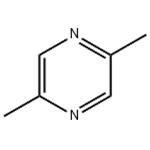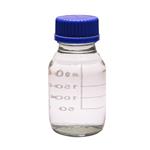2,5-Dimethyl pyrazine Production from Glucose by Genetically Modified Escherichia coli
Jan 16,2024
General Description
The previous research on 2,5-Dimethyl pyrazine production through fermentation has been limited, with more focus on tetramethylpyrazine. However, a recent study introduces a novel approach using genetically modified Escherichia coli to produce 2,5-Dimethyl pyrazine from glucose instead of L-threonine. The researchers developed a high-yielding strain by modifying an L-threonine high-yielding strain and optimizing the oxidation of L-threonine. They also introduced additional genetic modifications to enhance 2,5-Dimethyl pyrazine production. Although the productivity of the modified strain was lower than that of previous studies, it demonstrated the potential for industrial-scale production. Further improvements are needed to increase carbon yield and reduce byproduct accumulation. Overall, this approach shows promise for efficient and scalable 2,5-Dimethyl pyrazine production from glucose using genetically modified E. coli.

Figure 1. 2,5-Dimethyl pyrazine
Limitation on 2,5-Dimethyl pyrazine Production by Fermentation
2,5-Dimethyl pyrazine is a crucial flavor compound commonly found in fermented products, including cocoa beans, soybeans, and Oolong tea. 2,5-Dimethyl pyrazine is also recognized as a primary indicator of roasted peanut flavor. Since 1997, researchers have speculated on the biosynthetic pathway of 2,5-Dimethyl pyrazine in microorganisms, with evidence supporting similar pathways in ants and Bacillus subtilis. However, there has been limited research on the production of 2,5-Dimethyl pyrazine through fermentation methods. Previous studies have primarily focused on solid-state fermentation using soybeans and L-threonine as substrates. In contrast, tetramethylpyrazine (TTMP), another significant flavor compound, has received more attention in microbial fermentation research. The reasons behind this disparity are unclear, but potential factors include the difficulty in developing high-yielding strains, challenges in optimizing the fermentation process, and potentially higher production costs compared to chemical synthesis. Some studies have suggested that expensive L-threonine is required in large quantities for solid-state fermentation of 2,5-Dimethyl pyrazine. Overall, further research is necessary to optimize fermentation conditions and develop cost-effective approaches for industrial-scale production of 2,5-Dimethyl pyrazine. 1
2,5-Dimethyl pyrazine Production from Glucose by Genetically Modified Escherichia coli
A study presents a novel approach, known as the Accelerated Green Process, for the production of 2,5-Dimethyl pyrazine (2,5-Dimethyl pyrazine) from glucose using genetically modified Escherichia coli (E. coli). This is the first report of utilizing glucose as a substrate for 2,5-Dimethyl pyrazine production instead of L-threonine. The researchers constructed a high-yielding strain capable of producing 2,5-Dimethyl pyrazine by modifying an L-threonine high-yielding strain. Through their investigation of various Threonine Dehydrogenases (TDHs), it was observed that different TDHs exhibited significant differences in catalyzing the oxidation of L-threonine to L-2-amino-3-ketobutyrate, despite similar expression levels in E. coli. The strain overexpressing EcTDH displayed the highest enzyme activity and 2,5-Dimethyl pyrazine production, while AhTDH, AspTDH, and PhTDH showed the lowest activity and production. To further enhance 2,5-Dimethyl pyrazine production, the researchers introduced heterologous expression of LcNoxE and SoAAO, which influenced the NADH/NAD+ ratio and intracellular aminoacetone levels, crucial factors affecting cell growth. Additionally, a hypoxia-inducible promoter Pvgb was employed to regulate the expression of SstT, thereby avoiding feedback regulation of L-threonine. The genetically modified strain T6-47-7 achieved a 2,5-Dimethyl pyrazine production level of 1.43 ± 0.07 g/L with a carbon yield of 6.78% and productivity of 0.715 g/(L·d) in shake-flask fermentation under hypoxia-inducible expression conditions. Although the productivity of T6-47-7 was lower than previous reports, which utilized L-threonine, it demonstrated the potential for industrial-scale production of 2,5-Dimethyl pyrazine using glucose as a substrate. Further improvements in carbon yield are necessary, considering the accumulation of byproducts (glycine and L-isoleucine) observed in strain T6-47-7. Inactivation of key enzymes in the biosynthetic pathway of 2,5-Dimethyl pyrazine could be a viable strategy to increase carbon yield. Additionally, step-by-step domestication methods can be employed to enhance the growth performance of recombinant strains, thereby further increasing 2,5-Dimethyl pyrazine productivity. In summary, the Accelerated Green Process offers a promising approach for the efficient production of 2,5-Dimethyl pyrazine from glucose by genetically modified E. coli. Further research is required to optimize carbon yield and improve strain performance, but the results suggest great potential for industrial-scale 2,5-Dimethyl pyrazine production. 2
Reference
1. Besson I, Creuly C, Gros JB, and Larroche C. Pyrazine production by Bacillus subtilis in solid-state fermentation on soybeans. Appl Microbiol Biotechnol, 1997, 47: 489−495.
2. Xu J, Yu H, Chen X, Liu L, Zhang W. Accelerated Green Process of 2,5-Dimethylpyrazine Production from Glucose by Genetically Modified Escherichia coli. ACS Synth Biol, 2020, 9(9): 2576-2587.
- Related articles
- Related Qustion
- 2,5-Dimethyl Pyrazine: Applications in Difluoromethylarylation and Toxicity May 8, 2024
2,5-Dimethyl Pyrazine, utilized in food, fragrance, and pharmaceuticals, holds both utility and potential toxicity, requiring careful regulation.
- 2,5-Dimethyl pyrazine: properties and applications Aug 29, 2023
2,5-Dimethyl pyrazine is a versatile compound with a unique odor and flavor. It is used in pharmaceuticals, fragrance production, and shows potential as an anticancer and antimicrobial agent.
- What is 2,5-dimethyl pyrazine? Jan 7, 2020
2,5-Dimethyl pyrazine (DMP) can be used as flavoring additives due to its intensive smell and very low odor threshold value. DMP can be produced by chemical and biological methods.
Fabrication methods for Tungsten trioxide EC films include sputtering, sol-gel and hydrothermal. Nanostructuring, regulating crystallinity, and hybridization improve Tungsten trioxide EC performance.....
Jan 16,2024APIPterostilbene shows promise as a cancer therapy agent. It inhibits cell proliferation and induces apoptosis in breast and cervical cancers, targeting key proteins and cancer stem cells.....
Jan 16,2024API2,5-Dimethyl pyrazine
123-32-0You may like
2,5-Dimethyl pyrazine manufacturers
- 2,5-Dimethyl pyrazine
-

- $0.00 / 1kg
- 2024-05-15
- CAS:123-32-0
- Min. Order: 1kg
- Purity: 0.99
- Supply Ability: 50000kg
- 2,5-Dimethyl pyrazine
-

- $5.00 / 1KG
- 2024-03-27
- CAS:123-32-0
- Min. Order: 1KG
- Purity: 98%
- Supply Ability: g-kg-tons, free sample is available
- 2,5-Dimethyl pyrazine
-

- $50.00 / 1kg
- 2024-02-24
- CAS:123-32-0
- Min. Order: 1kg
- Purity: 99%
- Supply Ability: 10 tons




